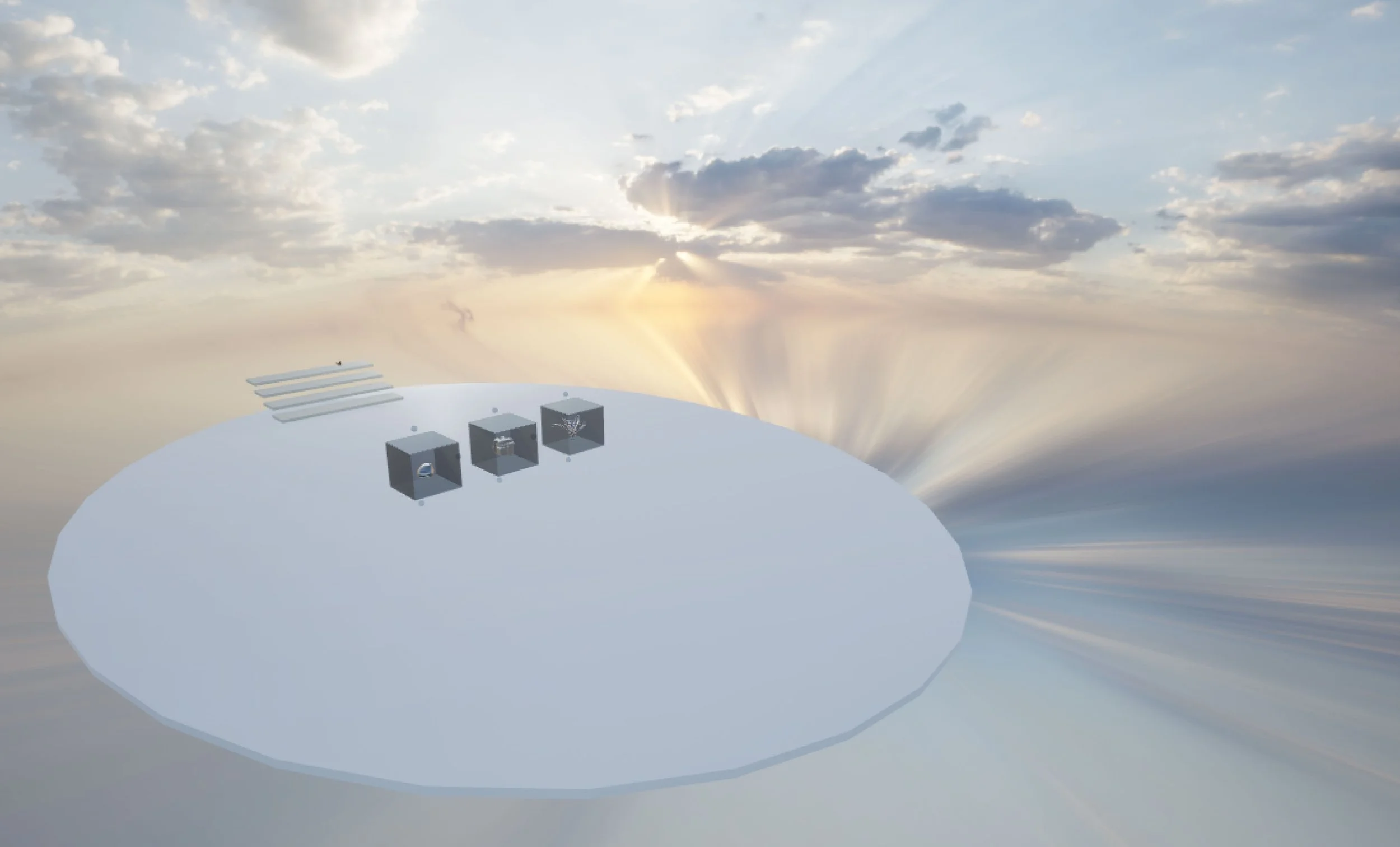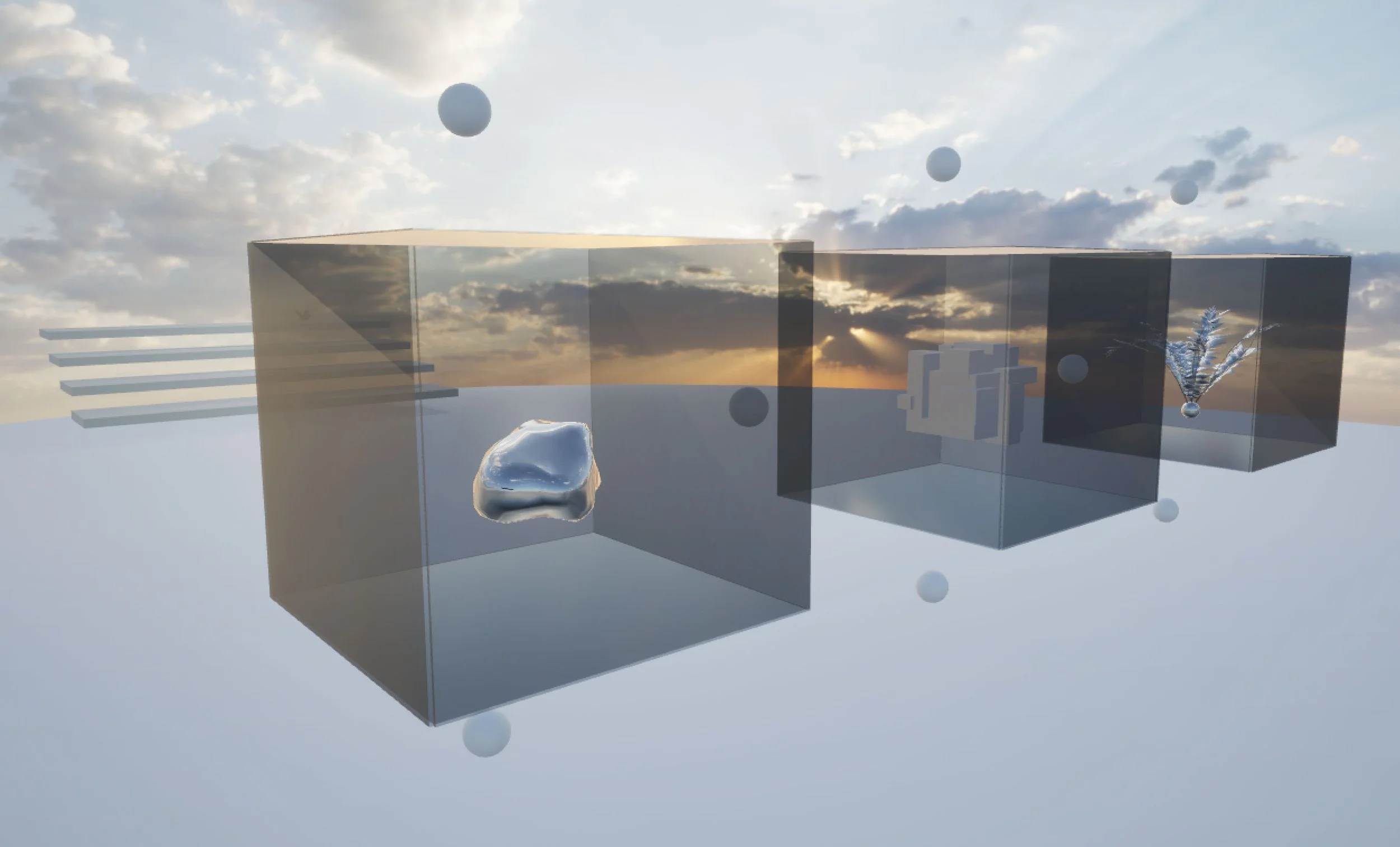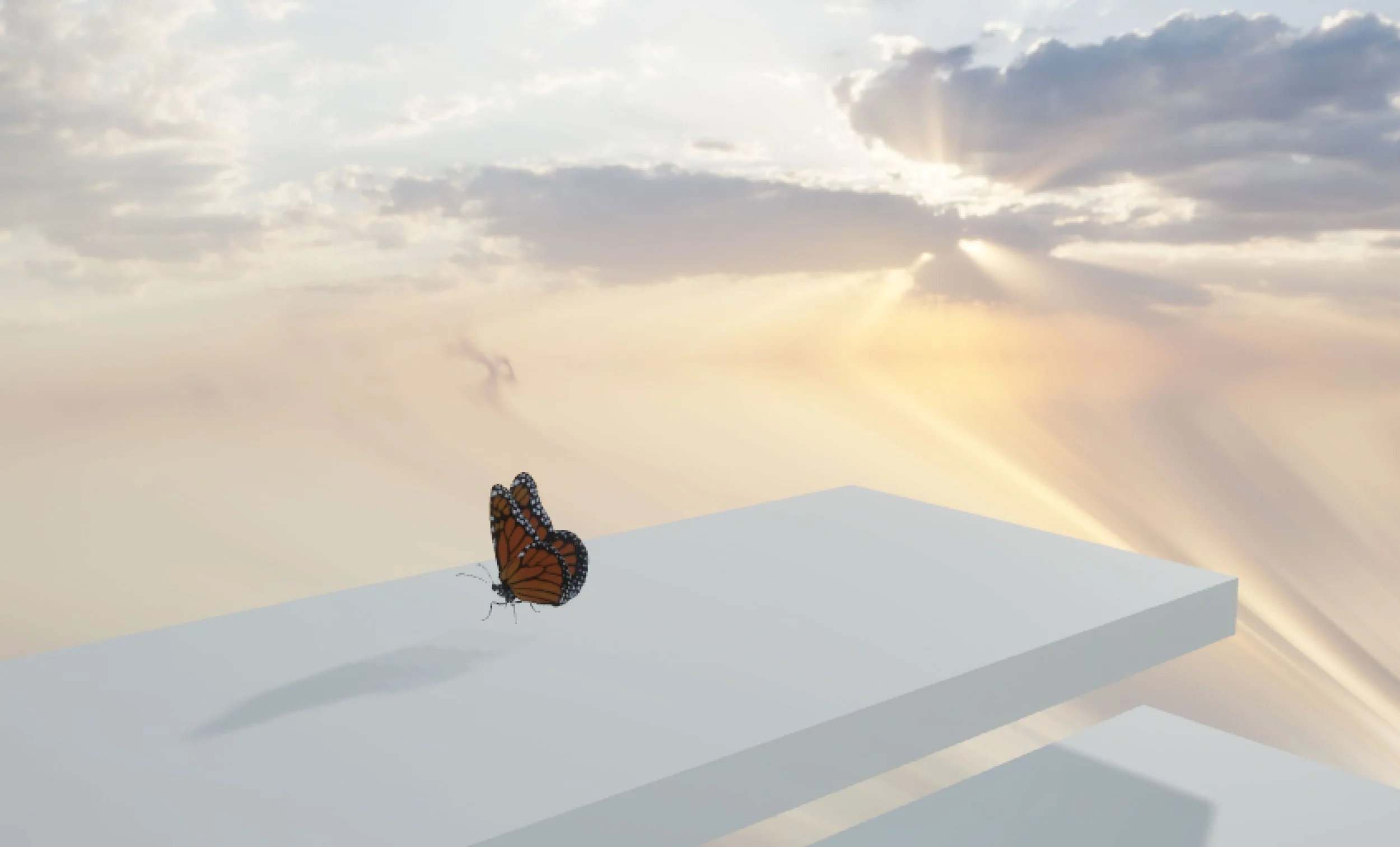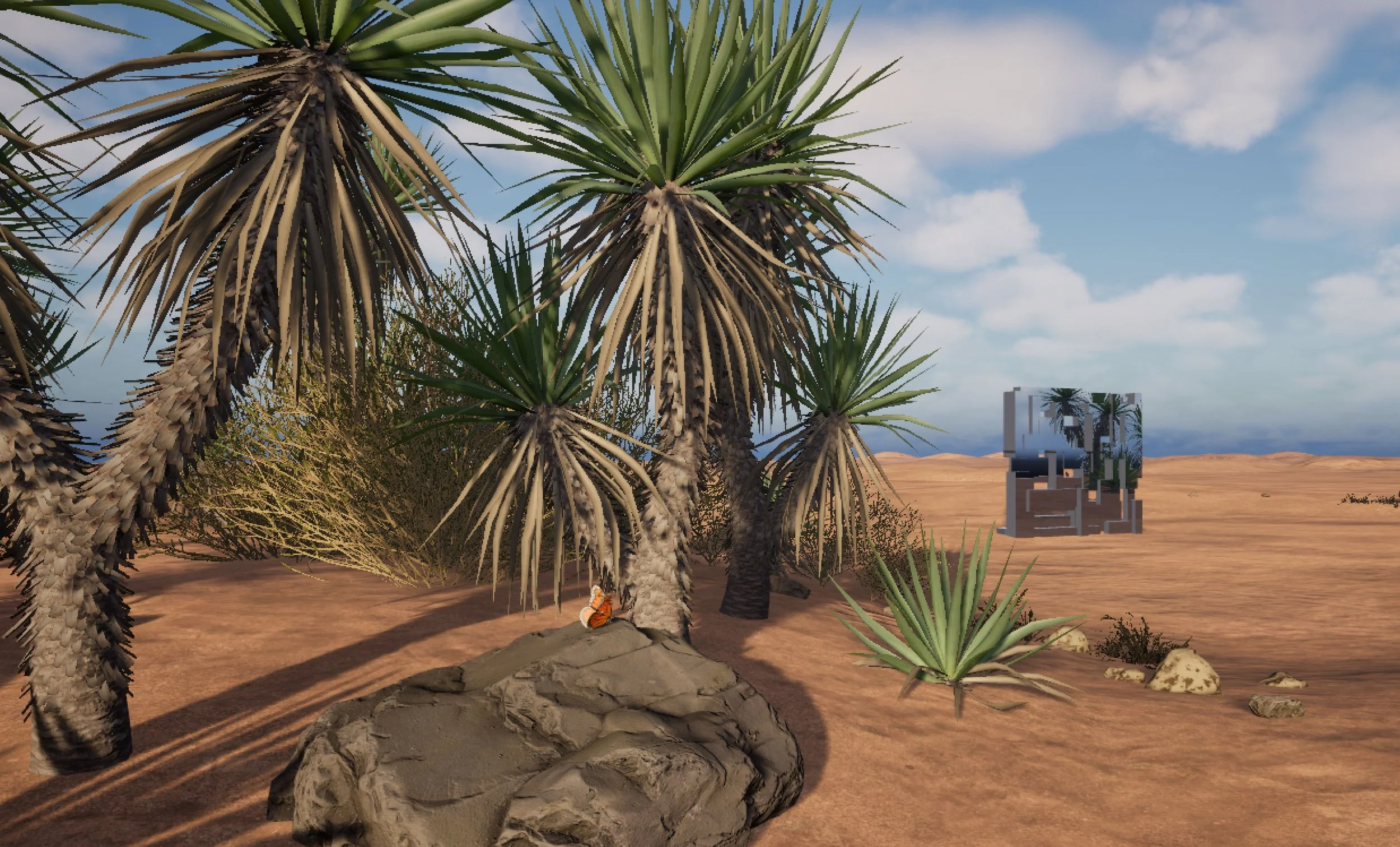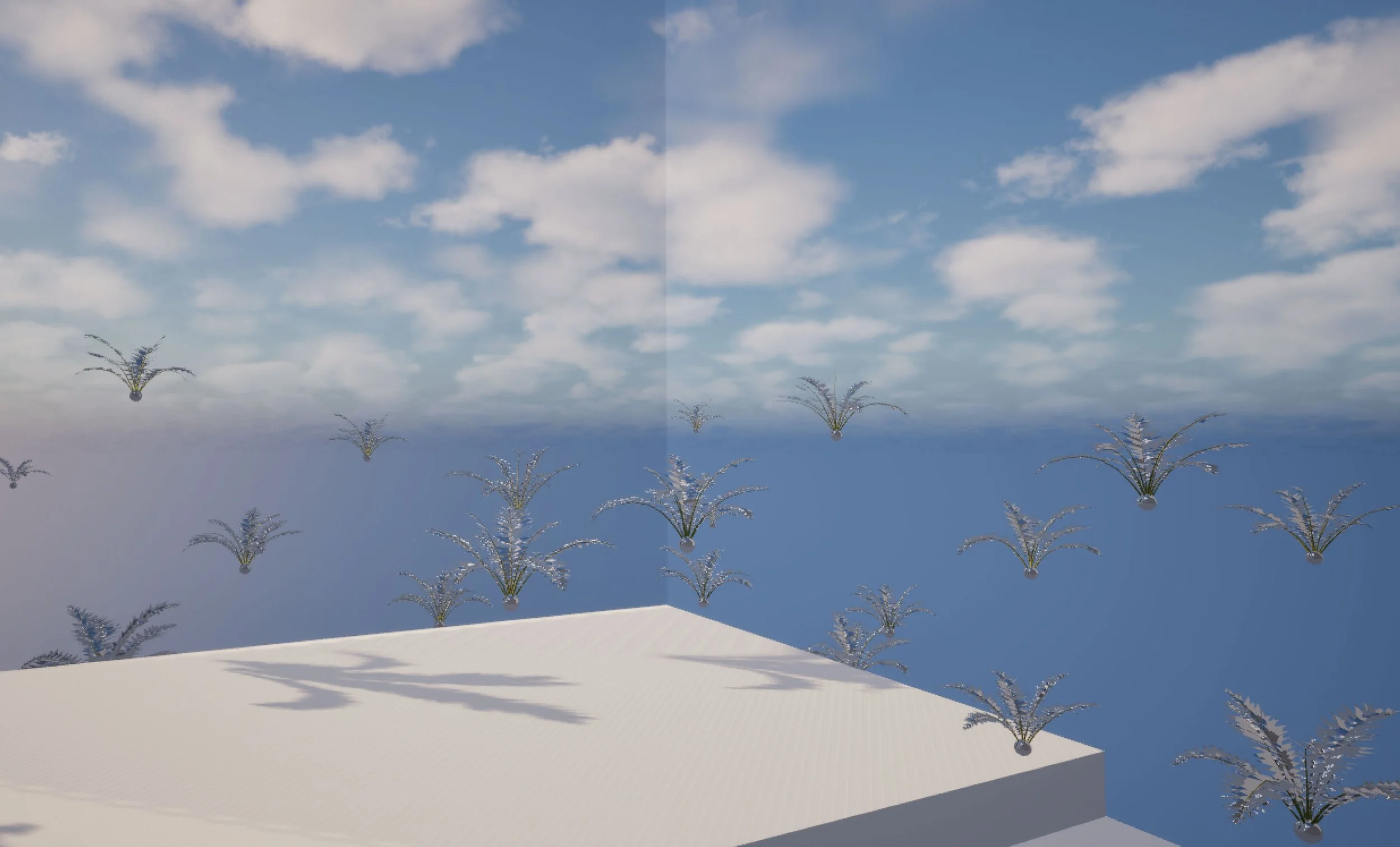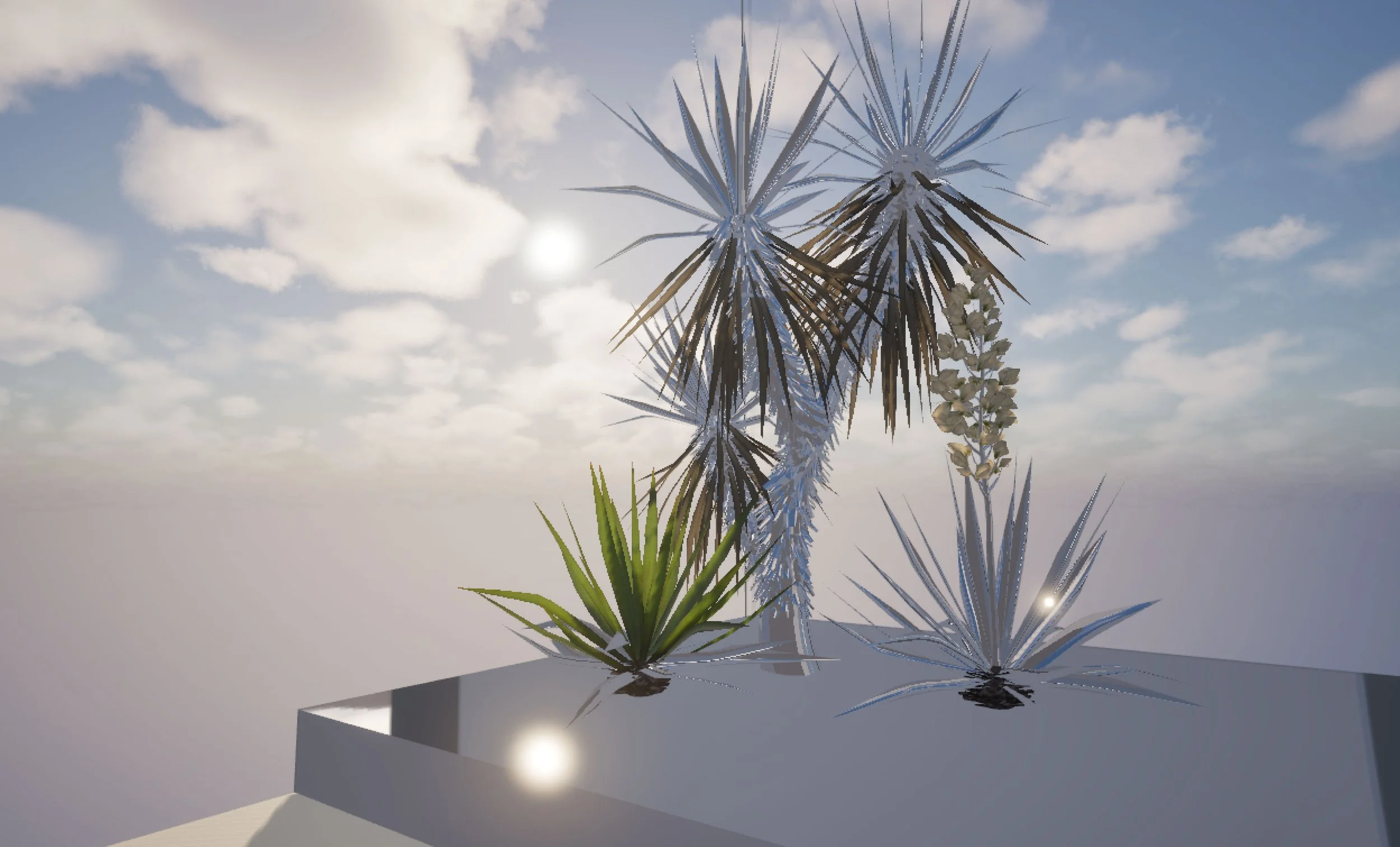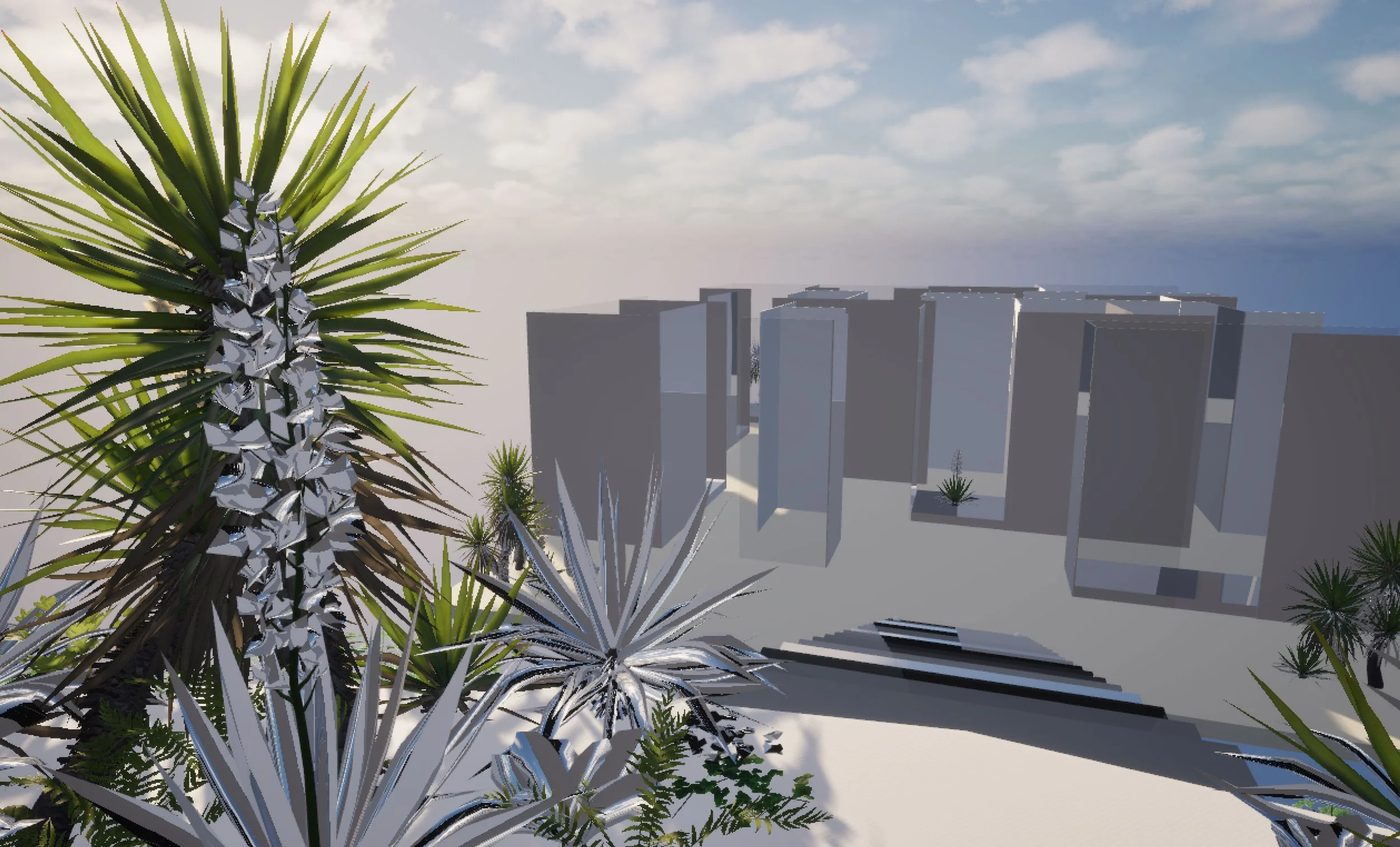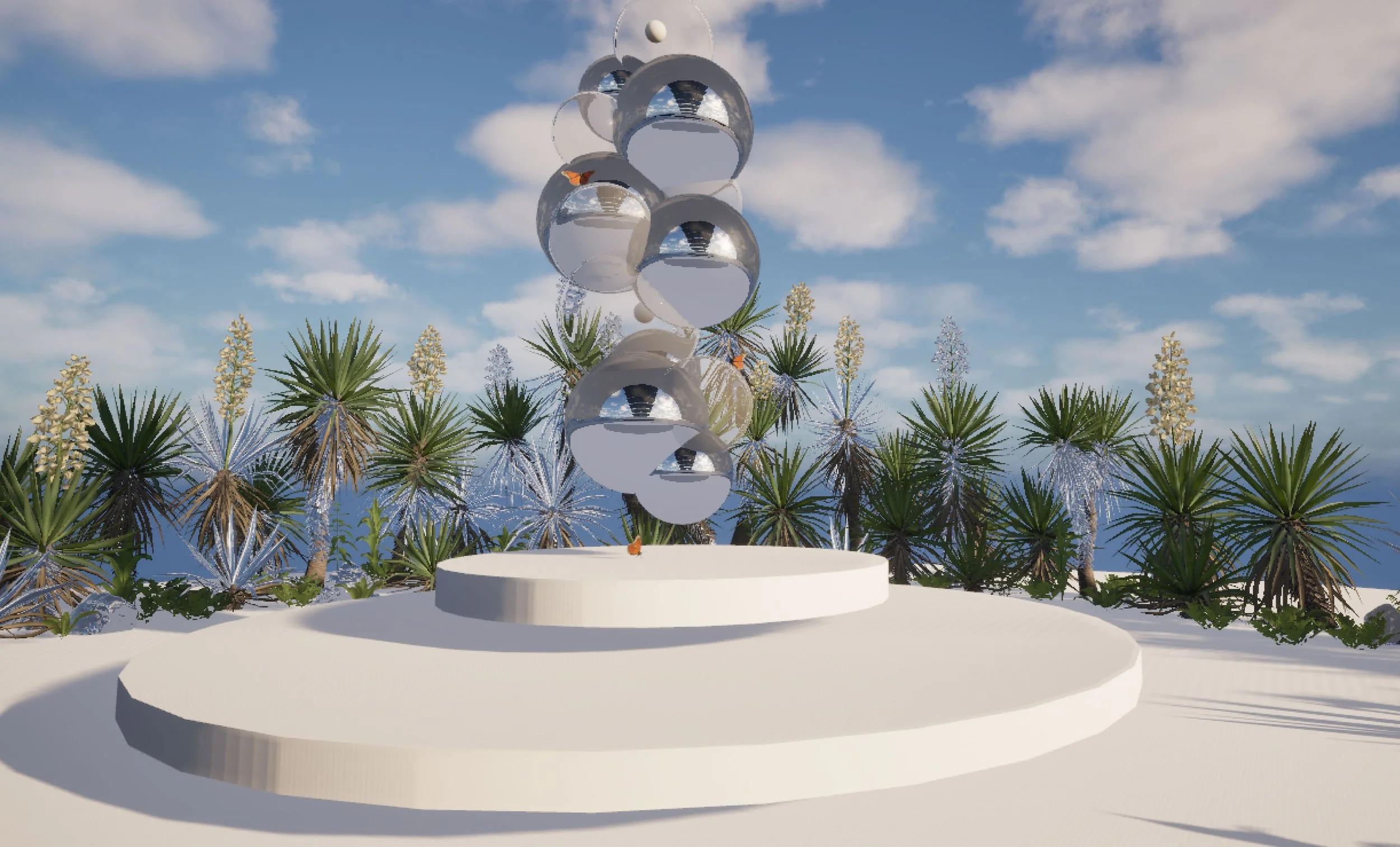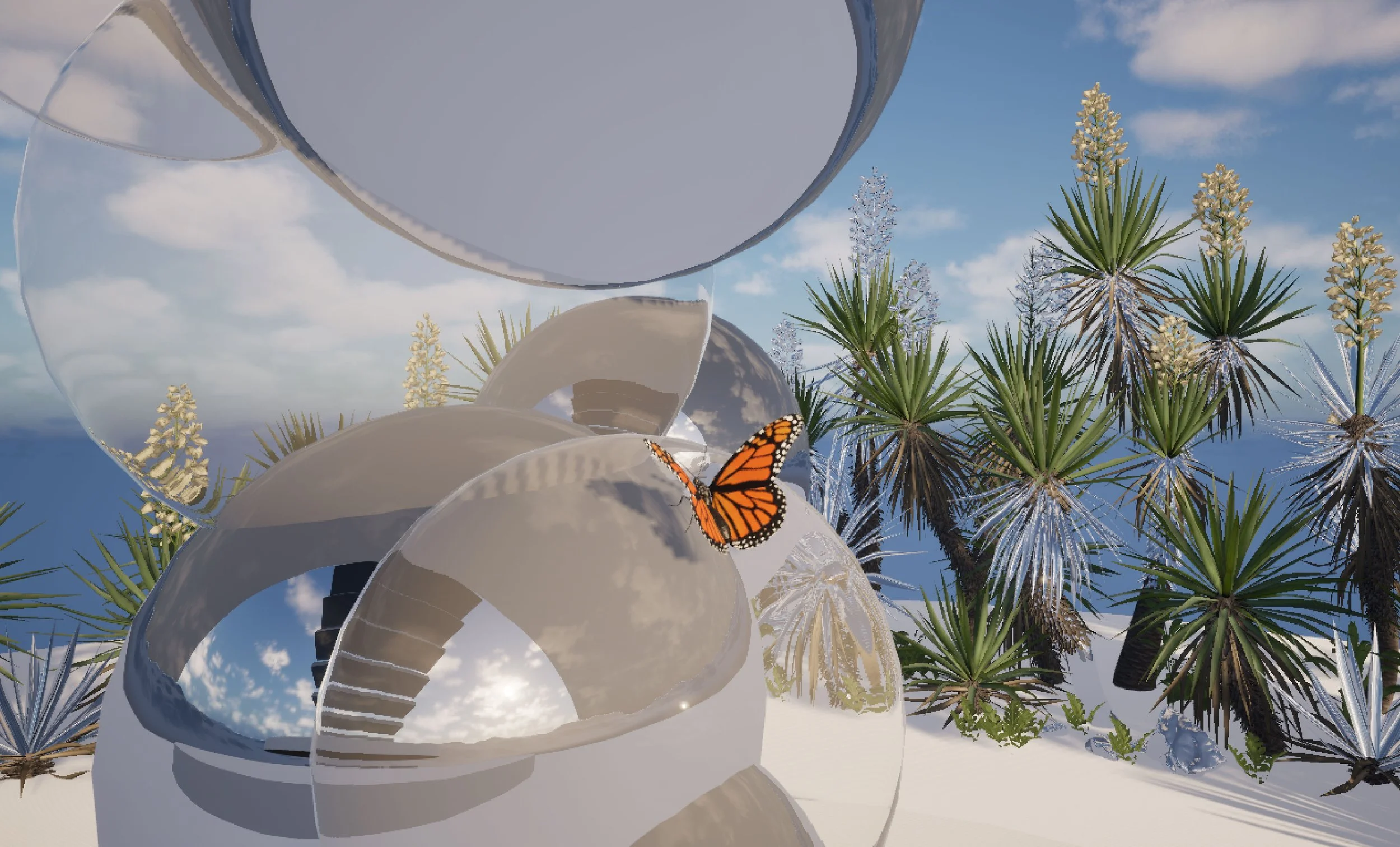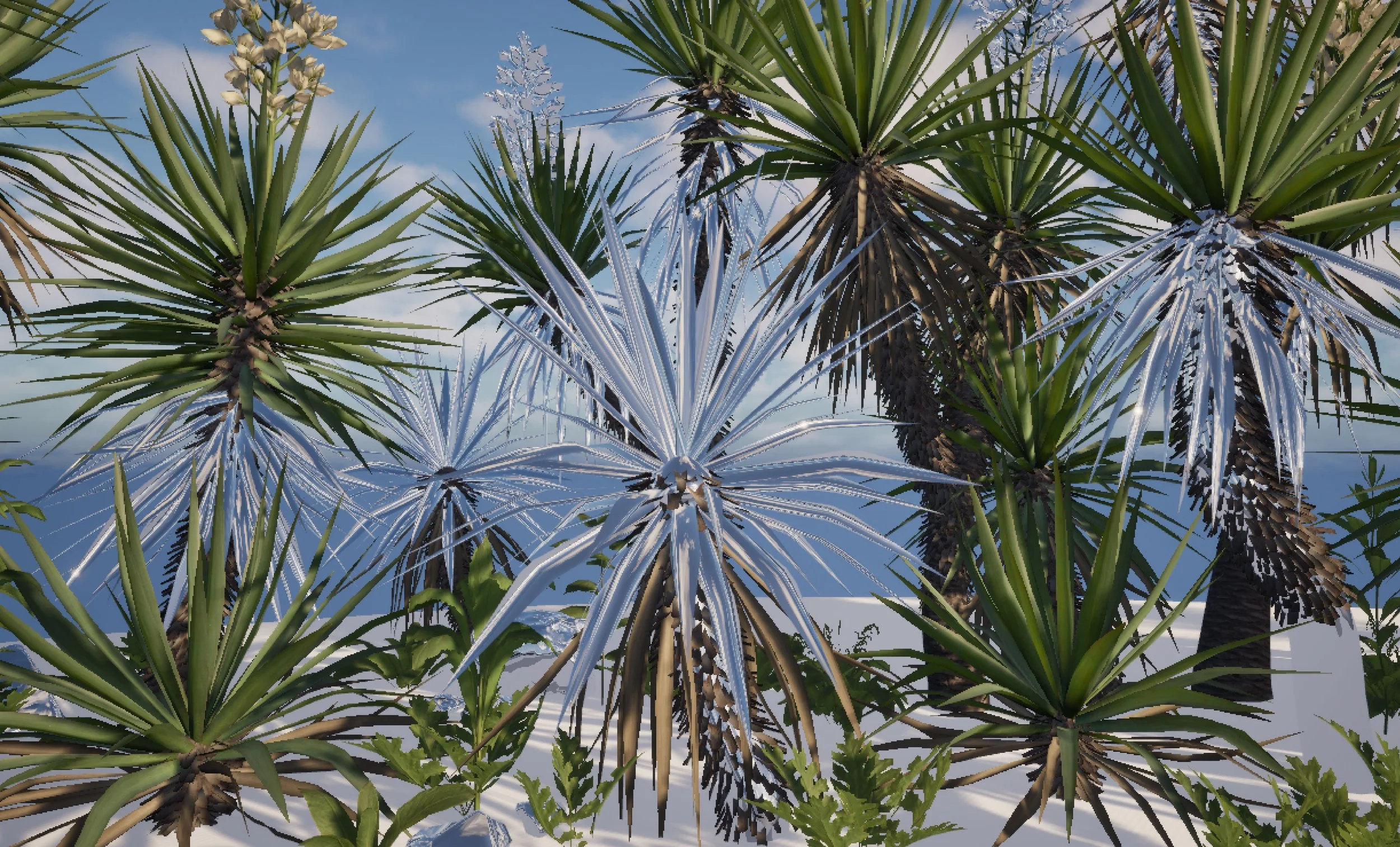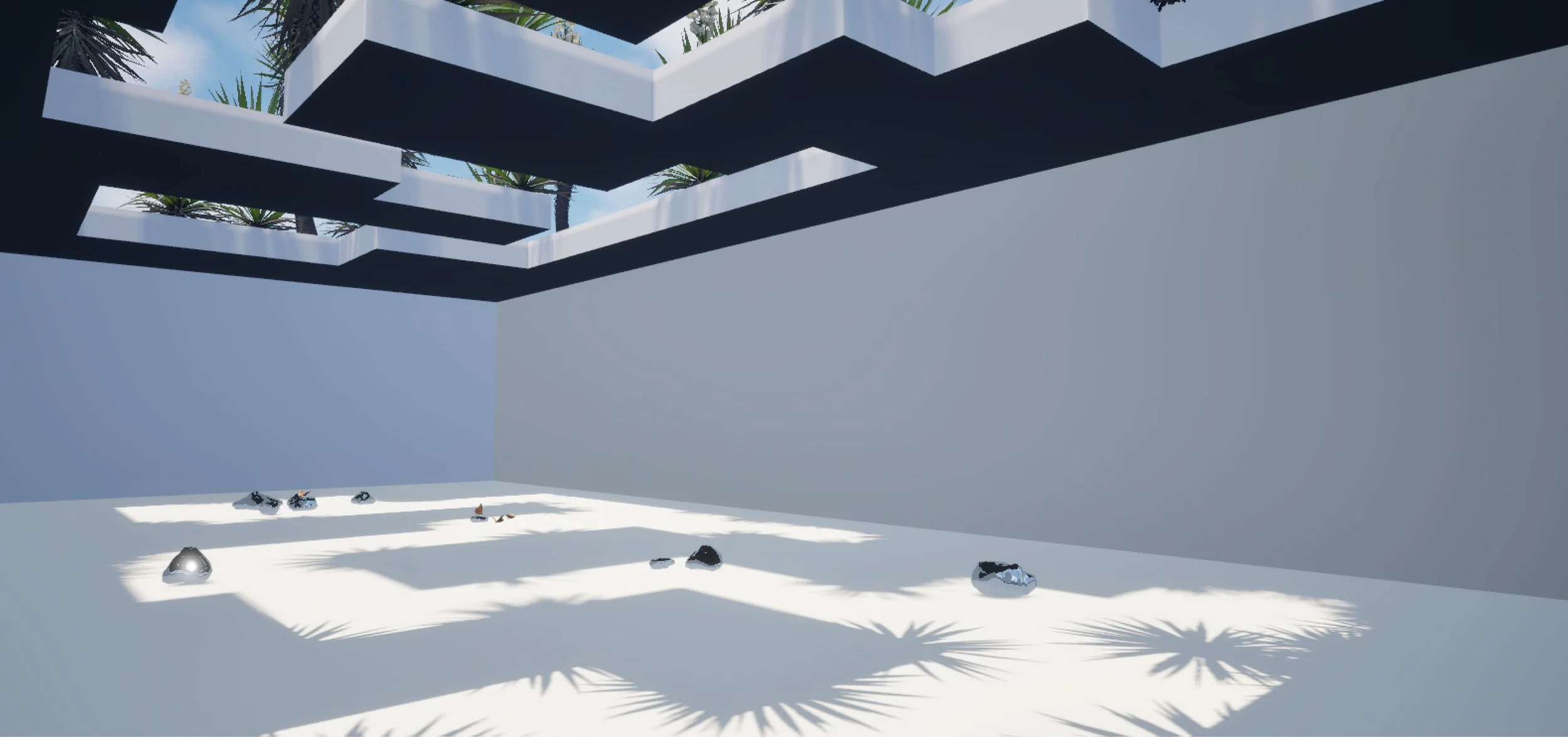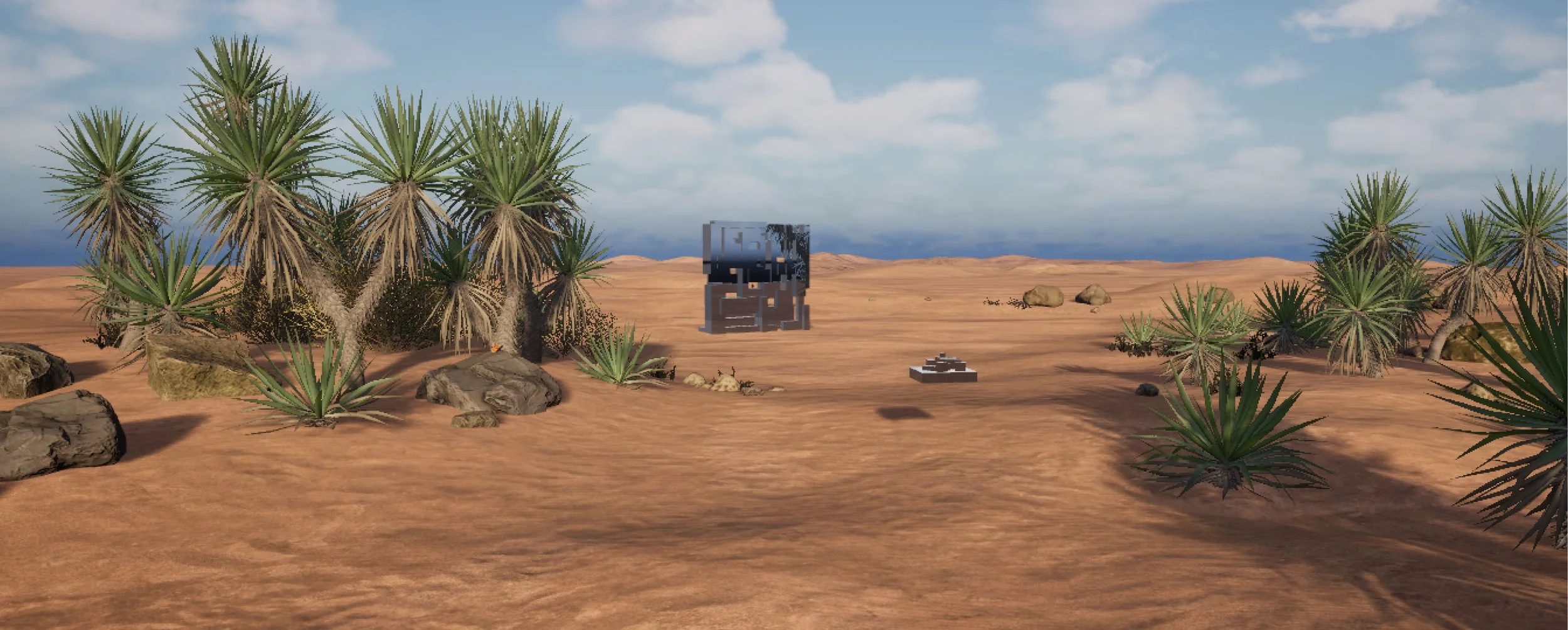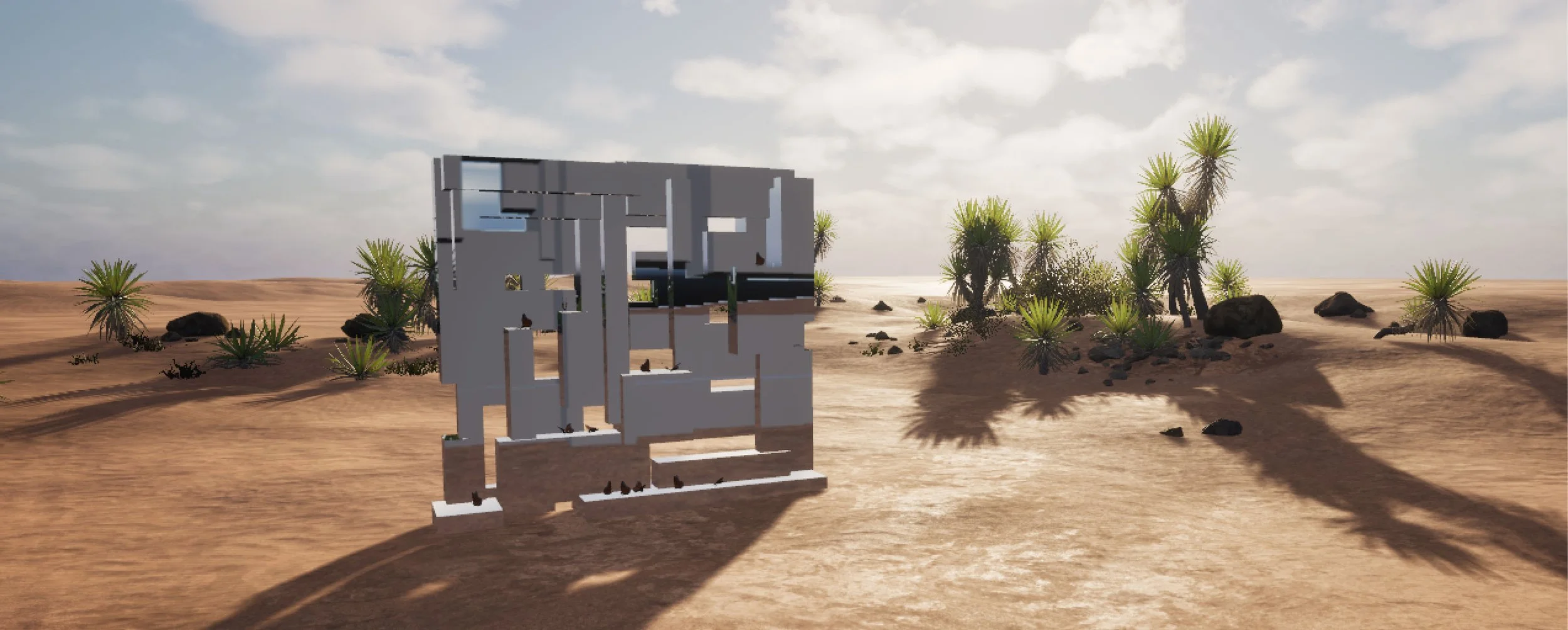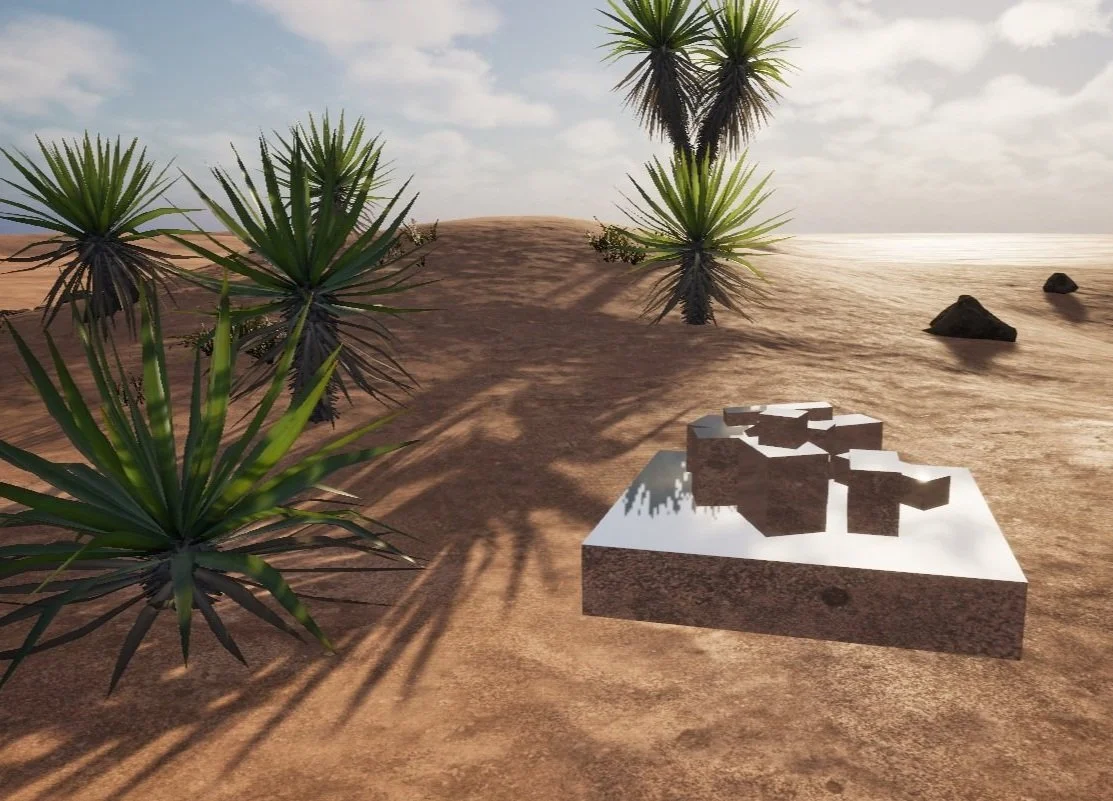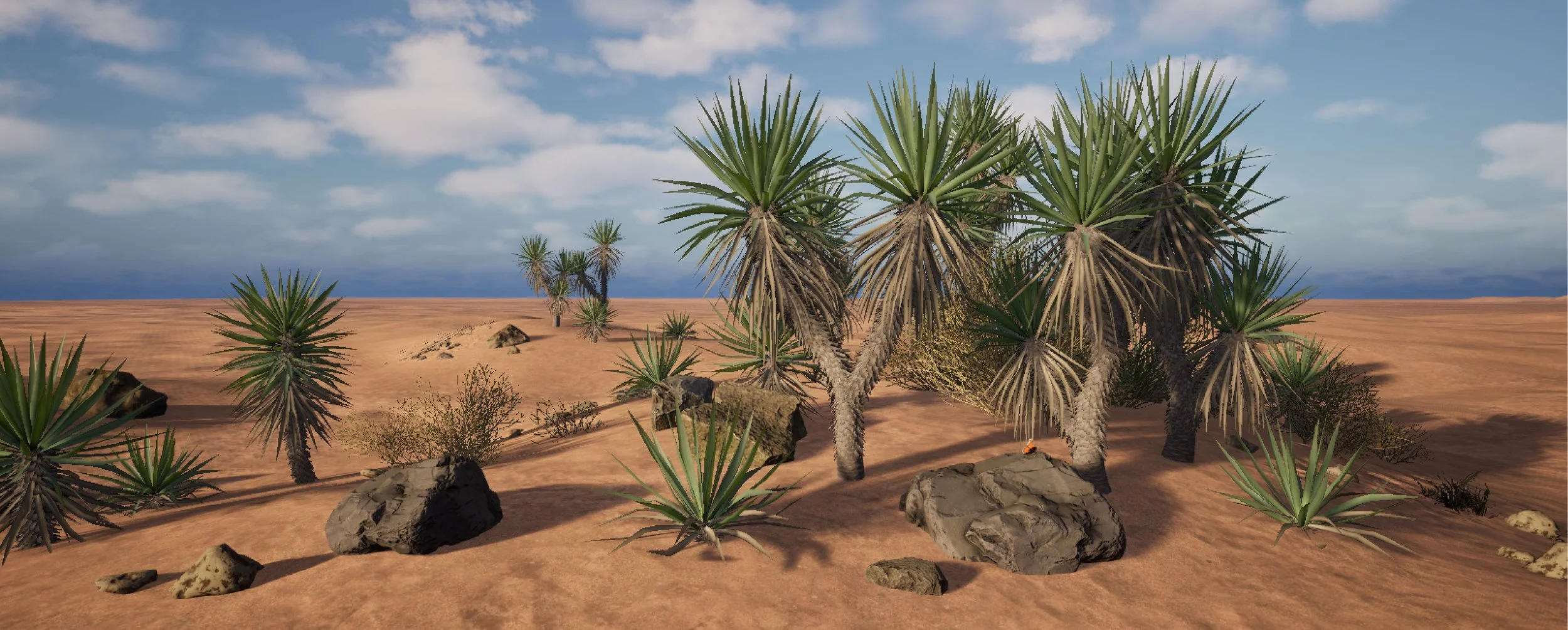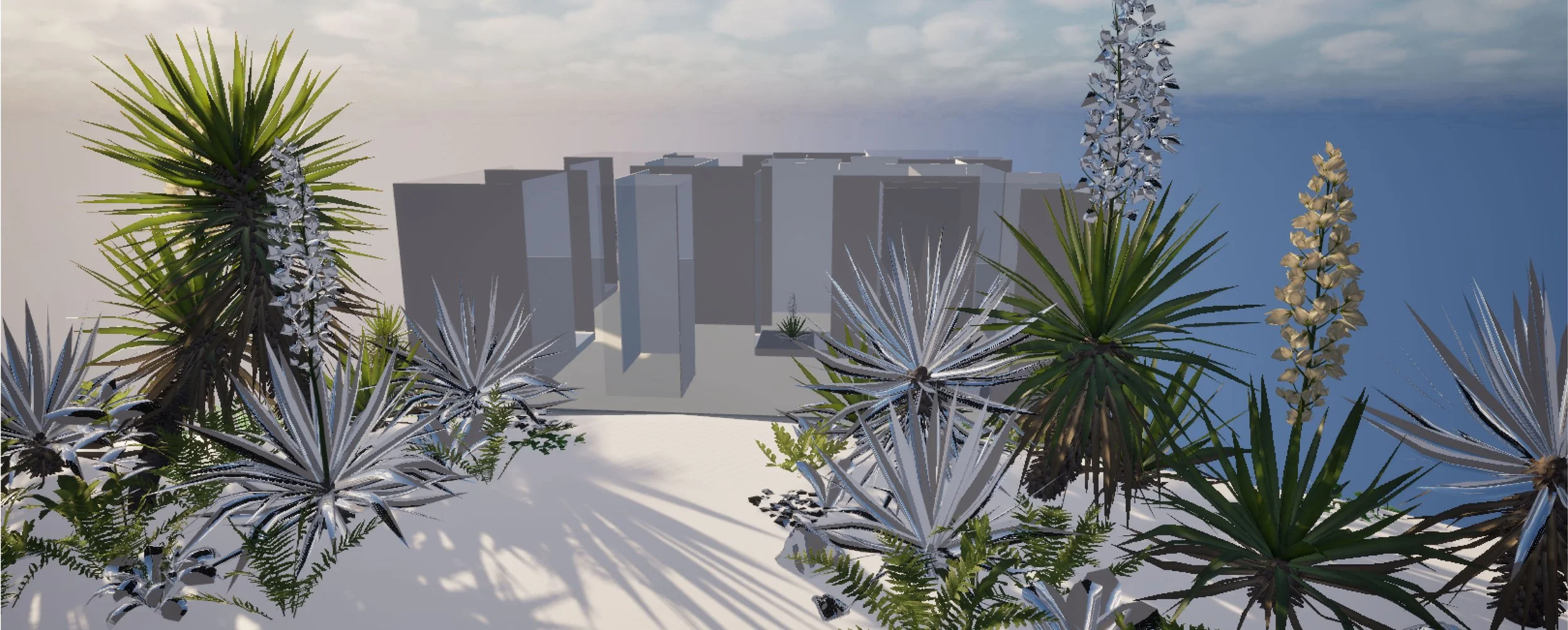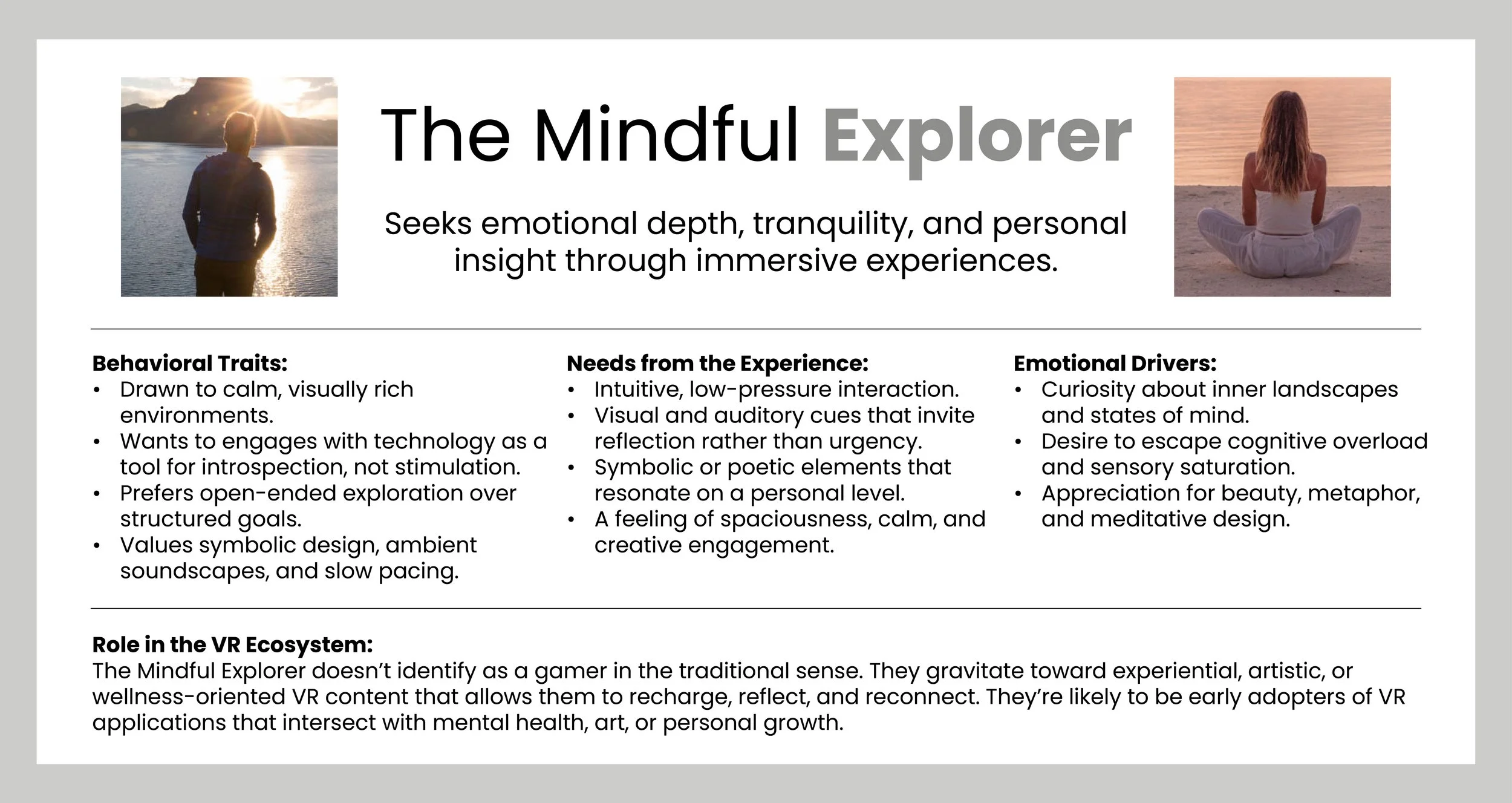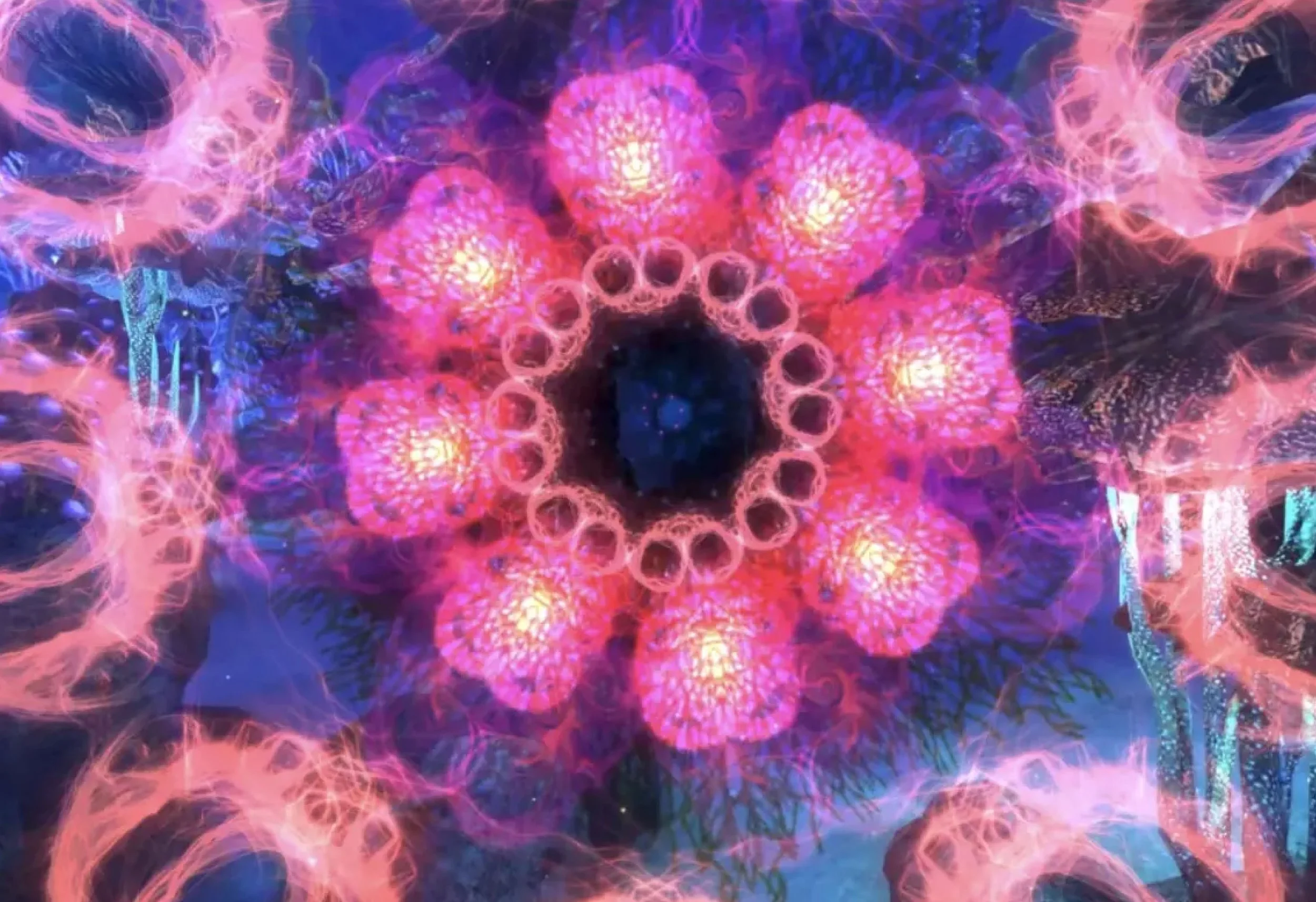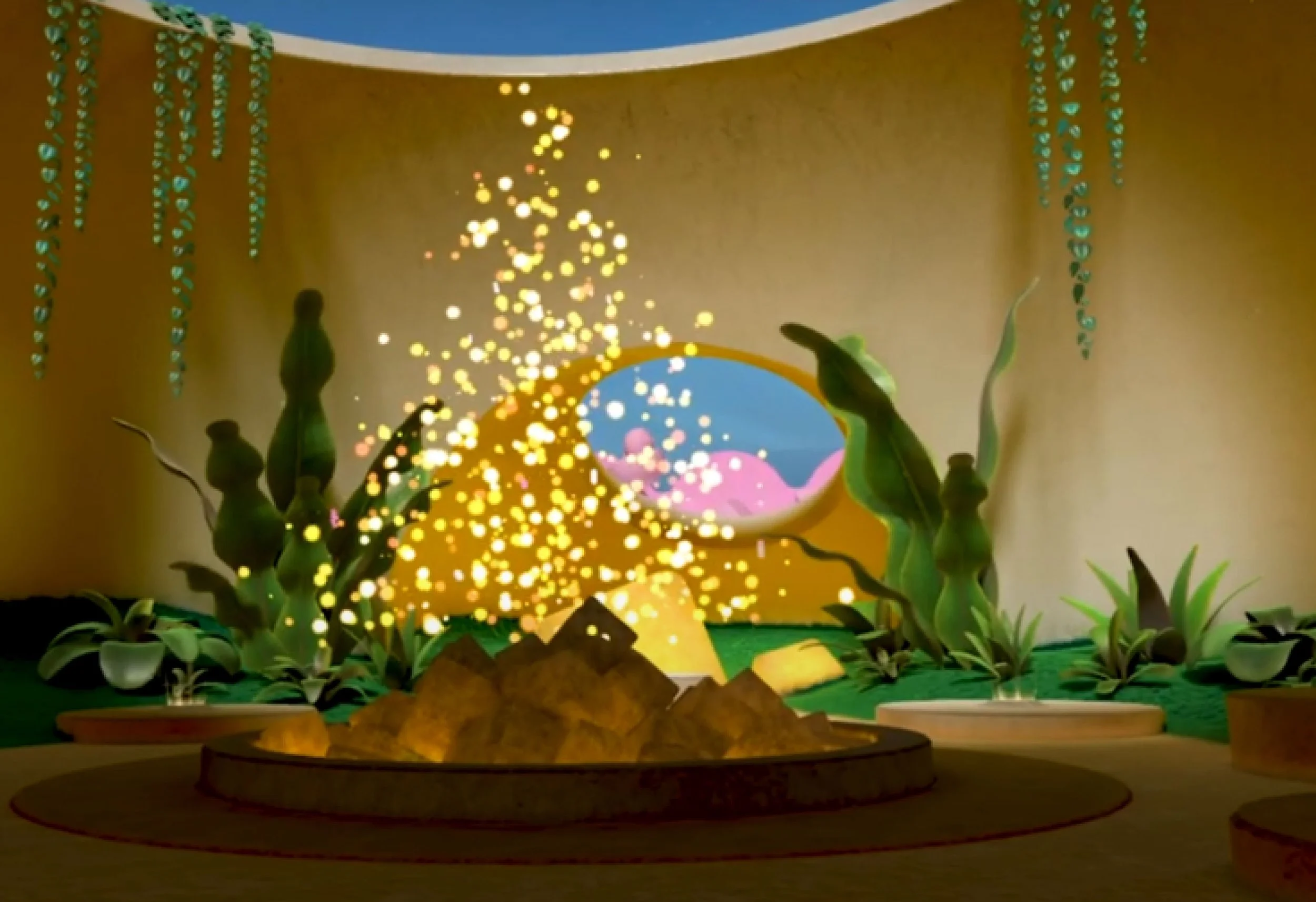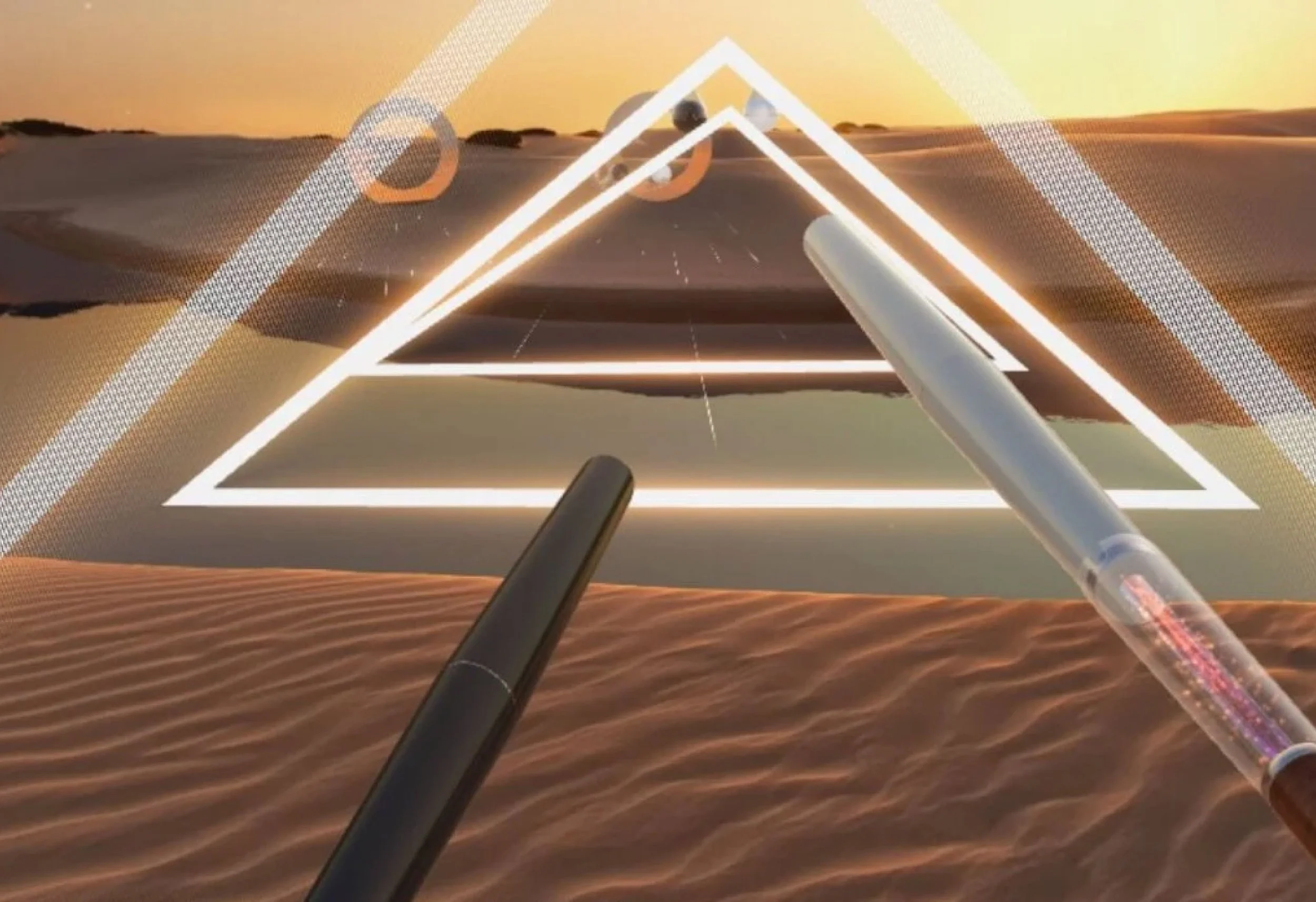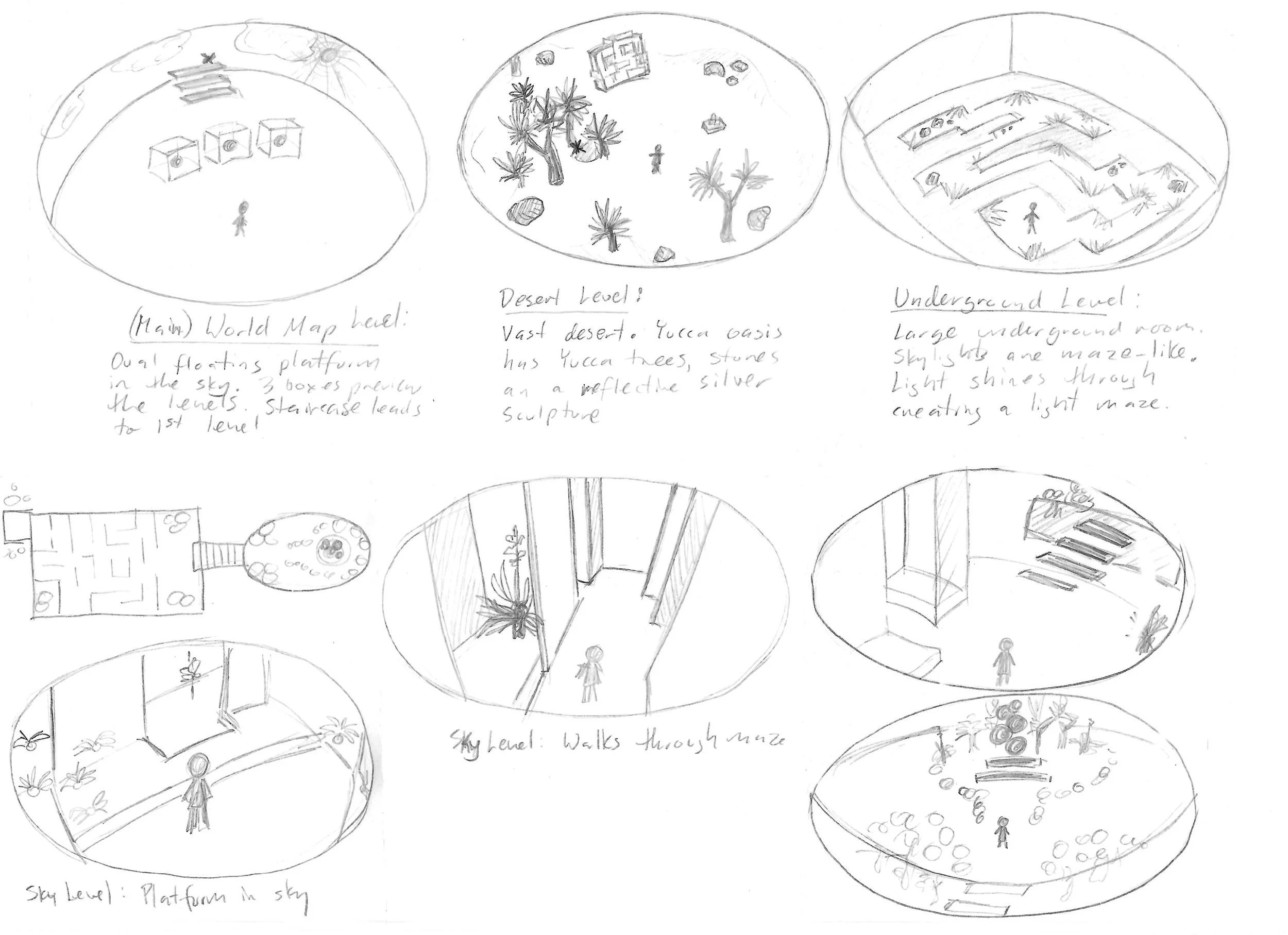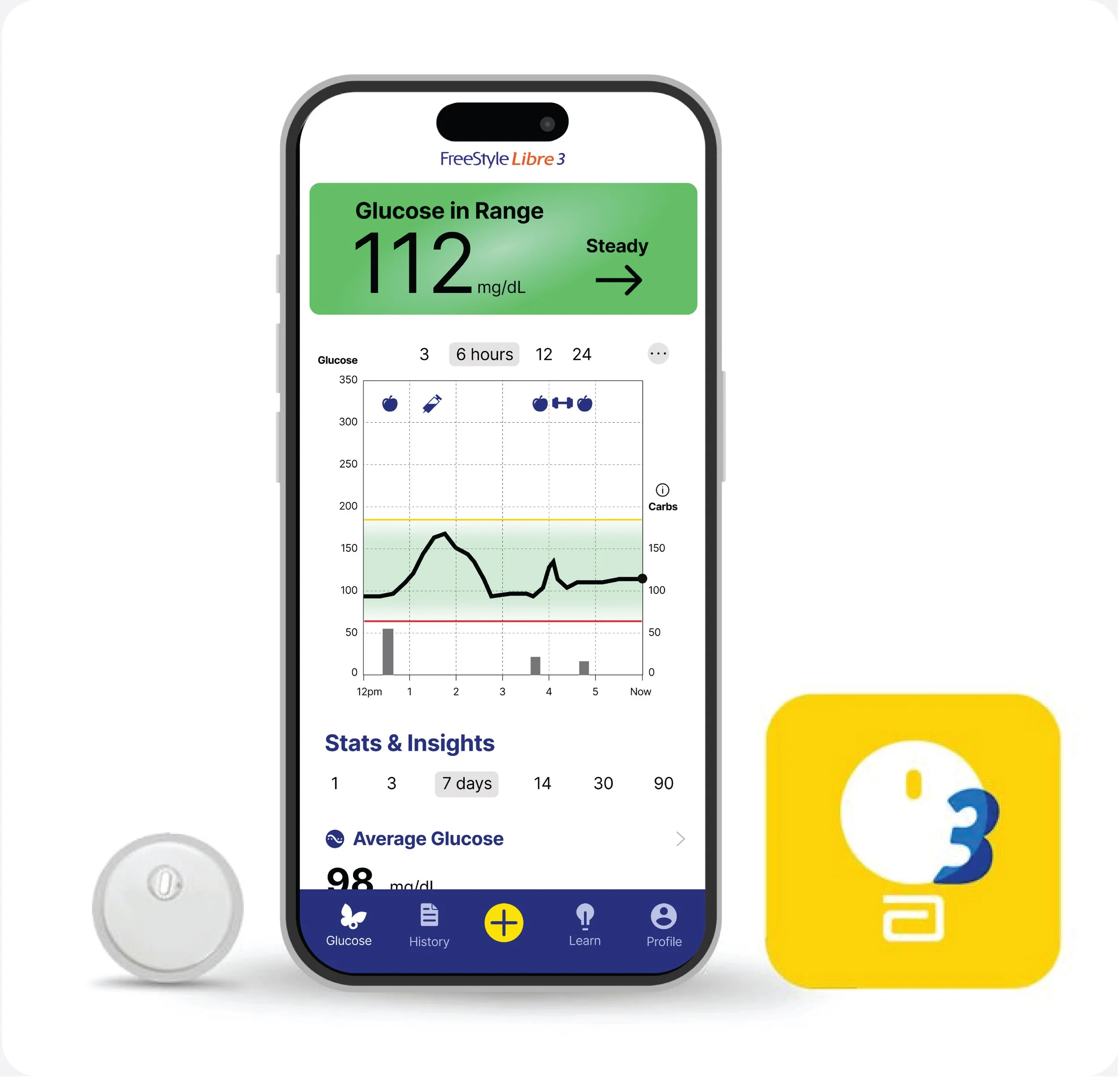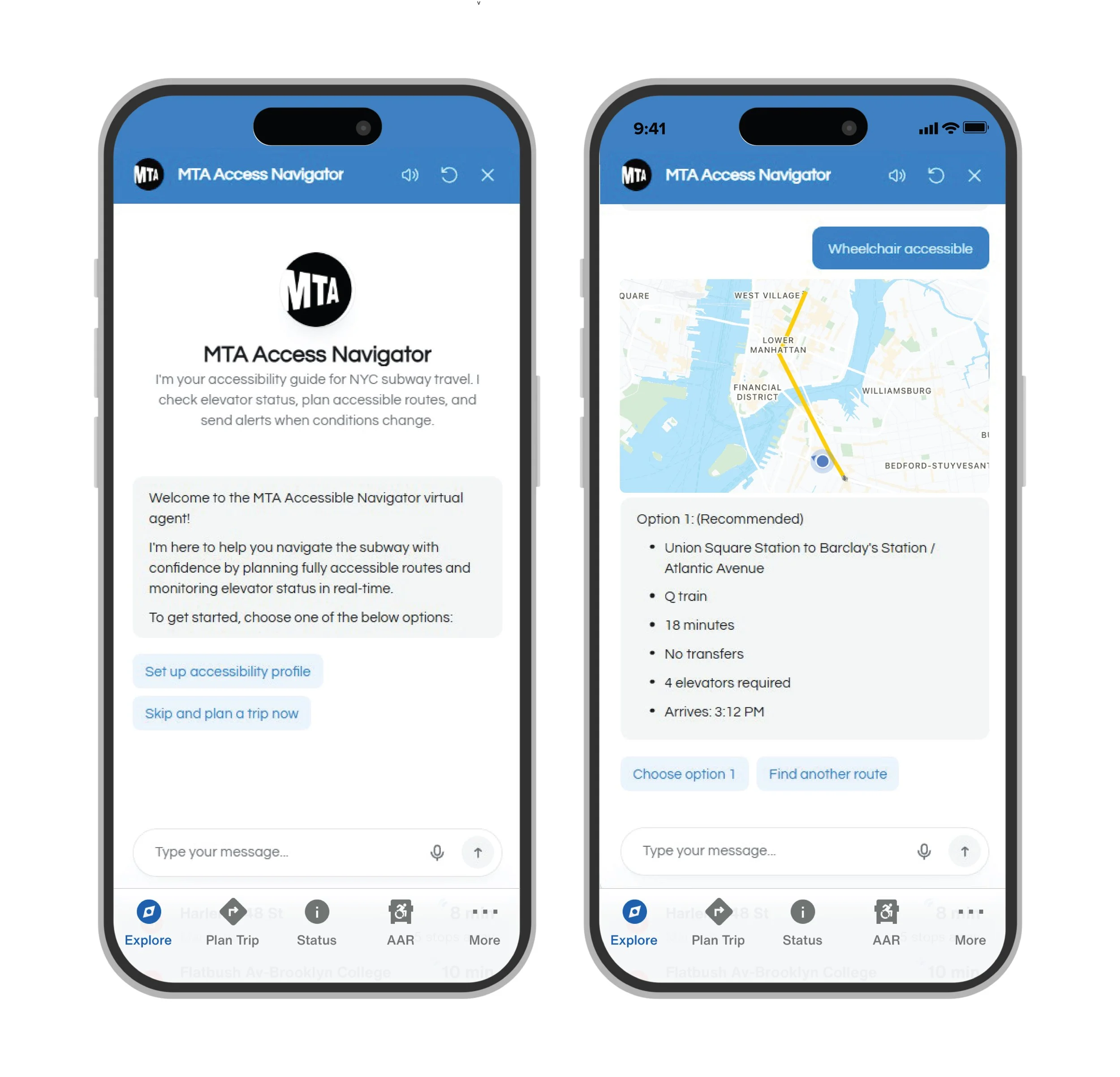
Spaces of Reflection
Exploring introspection through nature-inspired, surreal virtual spaces
Role: VR Immersive Experience Designer
Duration: 6 weeks
Tools: Unreal Engine, Meta Quest, 3D Asset Libraries, Audio Libraries, Illustrator, & Photoshop
01. Project Overview
Surreal Reflections
This immersive VR experience invites users to explore a series of reimagined natural environments designed for inspiration and reflection. Blending elements of the outdoors with surreal elements only possible in a virtual world, each setting encourages moments of stillness, exploration, and introspection. The theme of reflection is woven throughout, both metaphorically and through the use of reflective, mirrored objects, creating a space where users can encounter themselves and their thoughts in new, imaginative ways.
Unlike traditional games that revolve around conquest or combat, this experience offers a different kind of engagement, one where the "gameplay" centers on discovery, contemplation, and personal insight. Players are invited not to defeat enemies but to embrace curiosity, not to overcome obstacles but to cultivate wonder. The journey through these reflective landscapes becomes its own reward, offering a gentle invitation to slow down, observe, and find inspiration in both the extraordinary surroundings and the quiet moments of self-reflection they inspire.
02. The Challenge
-
The Problem
Many people seek moments of calm, reflection, and creative inspiration, but these are increasingly difficult to find in both the real world and digital spaces. Users who turn to VR hoping to relax, think deeply, or reconnect with themselves often struggle to find immersive spaces that truly support emotional stillness and personal insight. As a result, their needs remain unmet by most existing VR content, leading to disengagement, missed opportunities for emotional wellness, and limited use of VR as a tool for personal growth.
-
How Might We...
…design a VR experience that encourages introspection, emotional presence, and creative exploration without relying on traditional game loops, goals, or competition?
…design virtual spaces that spark creative inspiration and emotional curiosity?
…use visual storytelling and symbolism to inspire personal reflection within VR?
…create virtual worlds that feel emotionally uplifting and creatively engaging without overwhelming the user?
-
The Solution
If a VR experience is intentionally designed to promote calm, open-ended exploration and emotional reflection through immersive natural environments, ambient sound, and symbolic visual cues, users will feel more relaxed, inspired, and mentally present. This will lead to deeper engagement, increased emotional satisfaction, and a greater sense of personal connection to the experience.
03. Design
Process
This project began with a conceptual focus on meditative, nature-inspired spaces and evolved into an interactive VR experience grounded in visual storytelling and emotional engagement. I designed and built the experience in Unreal Engine, developing four distinct environments that blend organic forms with surreal, mirrored architecture. Early in the process, I established a visual and thematic foundation through mood board research, drawing from desert mirrors, botanical structures, and the symbolism of butterflies and mazes. From there, I translated those references into modular spatial designs and ambient lighting schemes, refining the aesthetic through constant playtesting. I prototyped the experience on a Meta Quest headset throughout development, which allowed for regular user testing and optimization. My workflow emphasized iteration—balancing visual richness with performance, and emotional tone with intuitive interaction.
World Map Level
The player begins on an oval platform suspended in a peaceful sky, with radiant sun shining through distant clouds. The player faces three intriguing glass display cases hovering in the air. Each transparent chamber contains a single distinctive object representing the three realms the player will travel to. White spheres drift back and forth, in measured patterns above, below, and between these showcases. At the distant edge of the platform stands a pristine white staircase, on its uppermost step is a solitary monarch butterfly with wings that flap gently. This ascending pathway guides the player toward their first destination.
Underground Level
This level unfolds within a minimalist, rectangular, underground chamber. A series of skylights punctuate the ceiling, with sunlight projecting a luminous maze-like pattern on the floor (foreshadowing the maze in the last level). Beyond the skylights, yucca trees sway gently, casting intricate, dancing shadows on the interior floor. Silver reflective stones are scattered throughout the light maze, which players can pick up and examine. As the player approaches the far end of the light maze, they discover more silver reflective rocks bathed in light, and a solitary butterfly perched atop the silvery surface of one rock, its wings opening and closing in a gentle rhythm.
Desert Level
The player traverses a serene, desert landscape with views stretching toward the horizon. A distinctive cluster of yucca trees grows in the arid terrain, accompanied by rock formations and a commanding geometric sculpture of reflective, polished silver. Visitors can wander among the yuccas, pause at a hovering platform to manipulate mirrored blocks, or approach the mesmerizing reflective monument where delicate butterflies have alighted on its silver surfaces.
Sky Level
The final level presents a mesmerizing maze of glass and mirrors where players weave through reflective pathways toward an floating sculpture, a collection of gleaming spheres rising from an unusual garden of silver yuccas. Their metallic fronds capture and scatter light across the environment. Throughout the labyrinth, plants thrive with leaves and petals that shimmer like polished metal. The entire space hovers across two floating platforms joined by a staircase, suspended in open sky with nothing but emptiness stretching below.
04. Interaction Design
Tactile Play in a Reflective Space
One of the interactive moments in the experience invites users to engage with a floating shelf of mirrored blocks. These objects can be picked up, examined, stacked, or gently tossed, offering a simple yet meaningful form of tactile engagement. While the interaction is low-stakes and open-ended, it creates a sense of presence and embodiment within the surreal environment. The reflective surfaces of the blocks echo the project’s broader themes of introspection, allowing users to playfully manipulate visual metaphors as part of their journey through the space.
05. Research
User Interviews
Before building the VR environments, I conducted a series of one-on-one interviews to better understand how people use immersive experiences to relax, reflect, or find creative inspiration. I spoke with a diverse group of 5 participants to explore their emotional needs, habits, and frustrations with current VR and other digital offerings. Many expressed a desire for slower, non-directive experiences that allowed space to think or simply be, without pressure to perform or follow instructions. Their input helped shape the early design vision by confirming a demand for VR that supports emotional depth, and sensory beauty over productivity or action.
User Archetype
Comparative Research
To better understand the landscape of wellness-oriented VR, I explored experiences such as Tripp, Headspace VR, and Supernatural. Each offered valuable insights into how immersive environments can influence mood and focus. Tripp emphasized guided meditation with layered visuals and breathing exercises, while Headspace VR introduced mindfulness concepts in a calm, structured format. Supernatural combined movement with inspiring environments and coaching for an energizing fitness experience. While each had strengths, I noticed a gap in offerings that emphasized open-ended exploration, symbolic storytelling, and emotional reflection without structured routines or external guidance. This research helped clarify both the opportunity and direction for Spaces of Reflection.
Designing for Emotional Presence
Creating a VR experience that invites users into a state of calm reflection required rethinking common assumptions about interactivity and engagement in immersive media. Without relying on goals or gamified progression, I needed to define what "meaningful interaction" could look like in a meditative context. This meant developing a design language that communicates emotional tone through space, symbolism, pacing, and atmosphere, while still offering users enough agency to explore freely and stay emotionally engaged.
I began with a series of conceptual explorations around emotional presence and visual metaphor, sketching out how space, light, and sound could shape a contemplative journey. I focused on natural references like desert plants, sky light, and organic motion to create familiarity, then introduced surreal, mirrored sculpture to suggest introspection and layered meaning. Symbolic elements like butterflies served as gentle guides, replacing traditional interface cues with visual storytelling. Below are a few of the assets I created or altered to use in the project.
06. Concept Development
Ideation
With storyboard sketches to plan the journey, quick VR drawings in Gravity Sketch for spatial mapping, rapid prototyping in Unreal Engine, and iterative playtesting, I refined the environments to strike a balance between sensory richness and mental spaciousness, designing for open-ended emotional response.
07. Usability Testing
User Feedback
User testing played a crucial role in shaping and refining the experience. Through user interviews and multiple rounds of hands-on playtesting sessions, participants (five users, ages 25-52, male and female) explored each environment while I observed patterns in their behavior, engagement levels, and emotional responses. Feedback highlighted which elements sparked curiosity, such as the mirrored objects and butterfly guides, and which areas needed adjustment, like improving object scale for easier interaction or softening transitions between levels. Users consistently expressed appreciation for the calming tone and visual aesthetics, validating the project’s core aim of fostering introspection. These insights directly informed design refinements, ensuring the final experience felt intuitive, immersive, and emotionally resonant.
User testing yielded predominantly positive results, with targeted opportunities for enhancement:
Participants successfully navigated all environments, readily identifying transition triggers between levels.
Interactive mirrored objects (rocks and blocks) received enthusiastic engagement from users across all testing sessions.
Several grabbable elements would benefit from increased scale to improve accessibility and interaction precision.
The butterfly guidance system proved intuitive, with users quickly recognizing their navigational function.
Participants expressed desire for extended observation periods with butterfly elements before level transitions occur.
Level transitions should incorporate more gradual fading or special effects to create smoother experience shifts.
The first iteration of the underground environment was too minimal and required additional interactive elements to increase dwell time and engagement depth. To achieve this, I added additional skylights to create the sunlight maze, and I added more rocks and butterflies throughout the maze.
